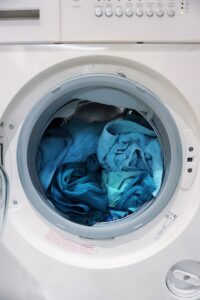A properly functioning dishwasher is a lifesaver in the kitchen, making the task of cleaning dishes quick and efficient. However, dealing with a dishwasher that isn’t filling with enough water can be incredibly frustrating. Low water levels can lead to dirty dishes, soap residue, and longer wash cycles. In this article, we will explore the reasons why your dishwasher may not be filling with enough water and provide troubleshooting tips to help you resolve the issue.
Key Takeaways
- Insufficient water supply is a common reason for a dishwasher not filling with enough water.
- Check the water supply line, water inlet valve, and float switch to ensure proper water flow.
- Low water pressure can cause symptoms such as dirty dishes, soap residue, and longer cycle times.
- Proper water levels are crucial for effective cleaning and preventing damage to your dishwasher.
- Troubleshoot by checking for clogs, leaks, and faulty parts such as the water inlet valve.
- A faulty water inlet valve can cause low water levels and should be replaced if necessary.
- The float switch helps regulate water levels and should be checked for proper function.
- Regular cleaning of the water inlet valve and filter can prevent clogs and ensure proper water flow.
- Call a professional if you are unsure or uncomfortable with troubleshooting your dishwasher’s water supply.
- Prevent future issues by regularly cleaning your dishwasher, checking for leaks, and maintaining proper water pressure.
Reasons why your dishwasher isn’t filling with enough water
There are several common reasons why your dishwasher may not be filling with enough water. One possible cause is clogged filters. Over time, debris and food particles can accumulate in the filters, restricting the flow of water into the dishwasher. Another potential culprit is a faulty water inlet valve. The water inlet valve is responsible for controlling the flow of water into the dishwasher, and if it is malfunctioning, it may not allow enough water to enter the appliance. Lastly, low water pressure can also result in insufficient water levels in your dishwasher. If the water pressure in your home is too low, it may not provide enough force to fill the dishwasher adequately.
How to check if your dishwasher is getting enough water
To check if your dishwasher is getting enough water, you can perform a simple test. Start by ensuring that the dishwasher is empty and free from any dishes or utensils. Then, turn on the dishwasher and let it run for a few minutes. After a few minutes, open the dishwasher door and inspect the water level inside. Ideally, there should be enough water to cover the heating element at the bottom of the dishwasher. If the water level is below this point, it indicates that your dishwasher is not filling with enough water.
Common symptoms of a dishwasher with low water pressure
A dishwasher with low water pressure can exhibit several symptoms that indicate insufficient water levels. One common symptom is dirty dishes. If your dishwasher is not filling with enough water, it may not be able to effectively clean your dishes, leaving behind food particles and residue. Another symptom is soap residue on your dishes. When there is not enough water in the dishwasher, the detergent may not dissolve properly, leading to soap residue on your dishes. Additionally, a dishwasher with low water pressure may have longer wash cycles as it tries to compensate for the lack of water.
The importance of proper water levels in your dishwasher
Proper water levels are crucial for the effective functioning of your dishwasher. Without enough water, the dishwasher will struggle to clean your dishes thoroughly. Food particles and residue may remain on your dishes, leading to unhygienic conditions and potential health risks. Insufficient water levels can also cause soap residue to be left behind, making your dishes appear dirty even after a wash cycle. Furthermore, a dishwasher that is not filling with enough water may have to run longer cycles to compensate for the lack of water, resulting in wasted energy and increased utility bills.
Troubleshooting tips for a dishwasher that won’t fill with enough water

If your dishwasher is not filling with enough water, there are several troubleshooting tips you can try before calling a professional. First, check the water supply to ensure that it is turned on and providing adequate pressure. If the water supply is fine, the next step is to clean the filters. Remove the filters from the dishwasher and rinse them under running water to remove any debris or food particles that may be clogging them. If the filters are clean and the problem persists, inspect the water inlet valve for any signs of damage or malfunction.
How to determine if your dishwasher’s water inlet valve is faulty
The water inlet valve is responsible for controlling the flow of water into your dishwasher. If it is faulty or malfunctioning, it may not allow enough water to enter the appliance. To determine if your dishwasher’s water inlet valve is faulty, you can perform a simple test. Start by turning off the water supply to the dishwasher. Then, disconnect the water supply hose from the valve and place it in a bucket or sink. Turn on the water supply briefly to see if water flows freely through the hose. If there is no water flow or if it is significantly reduced, it indicates that the water inlet valve is faulty and needs to be replaced.
The role of the float switch in regulating water levels in your dishwasher
The float switch is a small device located at the bottom of your dishwasher that helps regulate water levels. When the dishwasher fills with water, the float switch rises, signaling to the dishwasher that it has reached the desired water level. If the float switch is stuck or not functioning properly, it may prevent the dishwasher from filling with enough water. Inspect the float switch to ensure that it moves freely and is not obstructed by any debris or objects.
How to clean your dishwasher’s water inlet valve and filter
Regularly cleaning your dishwasher’s water inlet valve and filter can help prevent issues with low water levels. To clean the water inlet valve, start by turning off the water supply to the dishwasher. Then, remove the valve from the appliance and use a soft brush or cloth to clean any debris or sediment that may be clogging it. Rinse the valve thoroughly under running water to remove any remaining dirt. To clean the filter, remove it from the dishwasher and rinse it under running water to remove any debris or food particles. If necessary, use a soft brush to scrub away stubborn residue.
When to call a professional for help with your dishwasher’s water supply
While many issues with low water levels in your dishwasher can be resolved through troubleshooting and cleaning, there may be situations where it is necessary to call a professional for help. If you have checked the water supply, cleaned the filters, and inspected the water inlet valve, but your dishwasher is still not filling with enough water, it may indicate a more complex problem that requires professional expertise. Additionally, if the water inlet valve needs to be replaced, it is best to leave this task to a trained technician to ensure it is done correctly.
Preventative measures to avoid future issues with low water levels in your dishwasher
To avoid future issues with low water levels in your dishwasher, there are several preventative measures you can take. Regularly clean the filters to prevent debris and food particles from clogging them. Check the water supply periodically to ensure that it is turned on and providing adequate pressure. If you notice any signs of a faulty water inlet valve, such as reduced water flow or leaks, have it inspected and replaced if necessary. By taking these preventative measures, you can help ensure that your dishwasher functions properly and continues to provide you with clean dishes.
A properly functioning dishwasher is essential for efficient and hygienic dishwashing. Dealing with a dishwasher that isn’t filling with enough water can be frustrating, but by understanding the common causes and following troubleshooting tips, you can resolve the issue. Proper water levels are crucial for the effective cleaning of dishes and preventing soap residue. Regular maintenance, such as cleaning the filters and inspecting the water inlet valve, can help prevent future issues with low water levels. By taking these steps, you can ensure that your dishwasher continues to function properly and provides you with clean dishes every time.
If you’re experiencing issues with your dishwasher not filling with enough water, you’ll want to check out this informative article on 911 Appliance’s blog. The article titled “Dishwasher Won’t Fill With Enough Water: Diagnosing and Solutions” provides helpful tips and solutions to troubleshoot and fix this common problem. Whether it’s a clogged water inlet valve or a faulty float switch, this article will guide you through the steps to get your dishwasher back up and running efficiently. Don’t let a lack of water ruin your dishwashing experience – click here to read the full article and find the solution you need.
Is Insufficient Water the Cause of My Dishwasher Not Completing its Cycle?
If your dishwasher is not completing its cycle, diagnosing dishwasher cycle issues like insufficient water could be the cause. Check the water supply, inlet valve, and float switch for any blockages or malfunctions. Ensuring proper water flow is crucial for the dishwasher to run a complete cycle.



